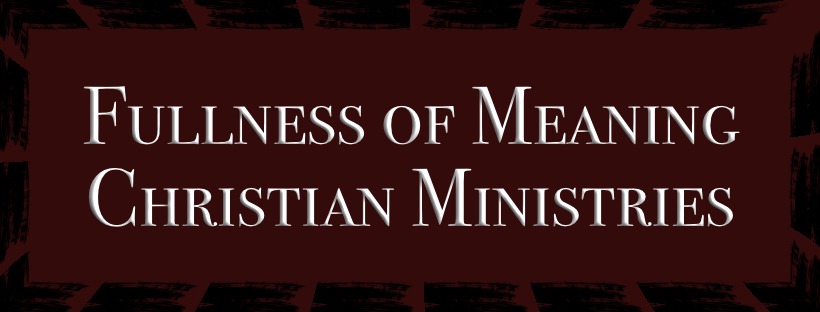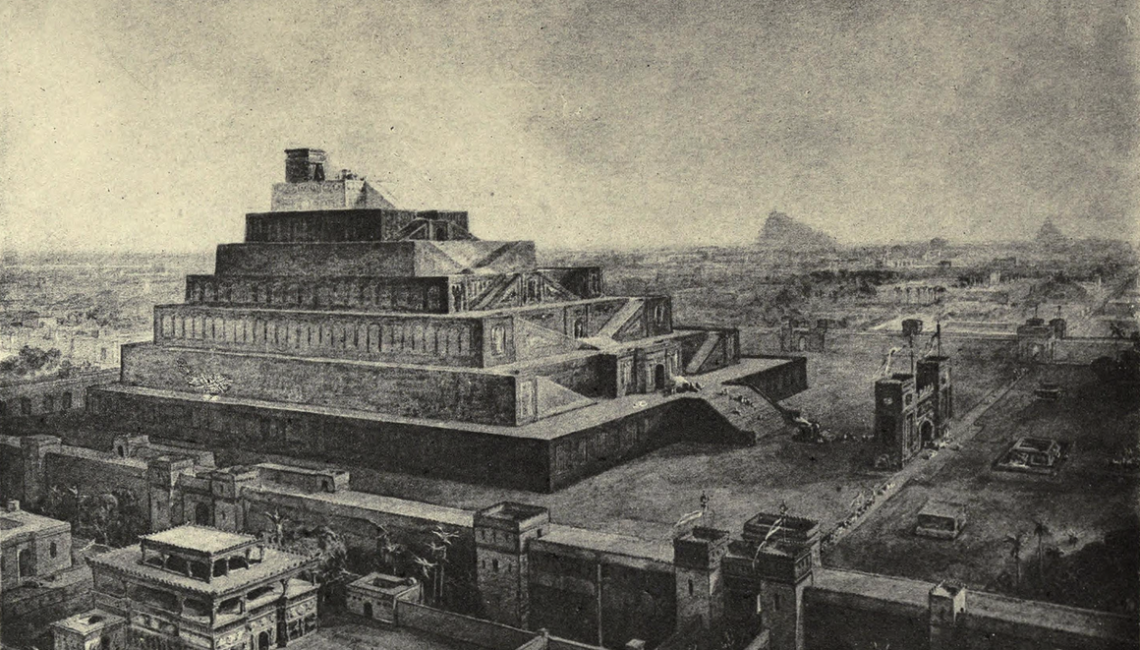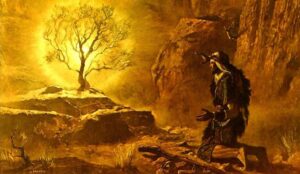The actors who ‘play out’ their relations between either YHWH and BAAL or the hedge of both.
The Sumerian, Indo European and Semitic world brought us meaningful natural occurring concepts that distinguish ‘categories’ and ‘territories’’ from another. From these natural occurrences, more abstract Theological, Philosophical and Mythological concepts were employed from their humble mundane beginnings. Mundane ideas such as “boundary lines”, “enclosures”, “circles”, led to more abstract theological notions as “heaven”, “earth”, “hell”, “salvation”, “damnation”, etc.
All of the Heavenly verbiage used in the Biblical text began with mundane-natural usages. From their literal-humble-bucolic and warring cultural references grew their *spiritual* language. Such spiritual language was the ‘figurative’ from their literal. Even to this day, those Semites who became Israel, carried their abstract Theological usages into a tightly knit fabric of natural to numinous.
For example: the bucolic “ox” was called “Strong One”. The letter, “ALEPH”, was and is the Semites and early Israel’s name for “God”. “Alpu”/ “Alpi” – Assyrian/ Babylonian; Hebrew: “Aleph” = “Ox” = “the strong one, the leader”. We see “ilu” in Assyrian/ Babylonian as, “High, Lofty, Heavenly”. We see, “EL” as, “God” in Hebrew. We see, once again, “heaven” in Hebrew as, “Shemayim”. This is a plural word. It can mean, ‘the waters (are up there)’, or, a deeper look into the natural usage could come from the “Semites” from whence we get the word, “Shem” – ‘authority’. Now, we have the hypothesis for the Sumerians to actually be the ‘Shem-arians’ as laid out by David Rohl. If this is true, then, the “whole world” was of ONE SPEECH prior to Nimrod’s assumption as the “Great Ox/ Aleph” which might have implied Dr. Anna Meshki’s work concerning Kartvelian and Sumerian ties. It is a complicated work, but, basically, Dr. Meskhi lays out the ‘key-code’ relationship between Kartvelian (Laz, Svan, Georgian- i.e, Caucasus language in the Steppe region near Armenia/ Ururtu/ Ararat all the way to Azerbaijan and North West Iran). This relation would have been forged by the great Nimrod/ Enmerker. The “SHEM” that Nimrod/ Marduk/ Enmerker/ Enmer/ Narmer so desired was “Speech as the Gods. Even in the Egyptian ideograph, the “ox’s tongue” {pronounced: “MR”} means – “over seer”/ “one who speaks with authority”. If the Egyptian “hypocoristicon (cropping off letters – both prefix/ suffix) due to cultural/ endonymic naming) applies to the FIRST PHAROAH of pre-dynastic Egypt, i.e., Narmer, it is possible that “MR” was his ‘nickname’ for it means all that Nimrod was in both ideogram and cultural meaning.
ONE SPEECH of ONE AUTHORITY by Nimrod. His temple (Ziggurat) would reach the “Heavens” — “The Lofty Place” of ecstasy. Prior to Nimrod, it is possible to conclude that the “black headed people”, i.e., the Sumerians/ Shemarians were the “sons and daughters of God”. If this is the case, then, “Shem, Heaven, Sumerian, Illu, Aleph, EL, etc. would have been generated from a nexus point, or tightly woven concentric idea that produced meaningfully related cognates. All from speech, elevation, strong, authority of the Aleph – the bucolic people’s idea of the ox and the superlative of that. To sum up the name game, in Dr. A.R. George’s work, “House Most High” page 72, Dr. George gives up 1,449 examples of Sumerian Ziggurats and the authority to their function. One striking ziggurat that I found in his book was called, B’ara.sur.ku = “Seat of Marduk” which meant in Sumerian: “Bara” = “Throne, Seat of Honor, Sanctuary, , Chapel, Shrine, Chamber, Dwelling, Dais, Abode” + “Sur” = “divide, demarcate, set parameter, to enclose” + “Ku” = “base/ to found”. Does this not sound like what Nimrod did when he tried to establish a SHEM for himself? Does this not sound like his division/separation from others (us and them) both means ‘division’ from his ‘country’/ ‘province’ vs. the rest of the world AND the ‘division’ that happened to his own language/ speech/ SHEM? All in ONE *name* of a Temple/ Ziggurat can we find the particulars to the Biblical Narration of Genesis 11!!
Figurations
Such natural elements as sea and sky are used to define two types of ‘never ending’.
Mountains to plateaus are used to express the journey’s end to the God on the Mountain where the Kingdom of God reigns. The ‘raqui’ or ‘firmaments’ explain the divisions of the Heavens that God made, yet, the ‘raqui’ also mean ‘steps’ in a Pyramid or ziggurat to the “Seventh Heaven” of its tower (the Top). Raqui also means, in the Semetic world, a pass through Mountains to get to the other side. The study of such a rich word employed by the Biblical Genesis Author knew the linguistic ‘gold’ to this word and its rich cultural heritage by which a contemporary of that day would have understood the limitations of raqui’s interpretation. We do not have that.
In heathen terms (I approach this from an ‘a-moral’ perspective), the ‘divisions’ of the sub-natural, natural and supernatural can be demarcated by natural objects that ‘signal’ the other world. To note, the old Hebrew stories in Genesis (pre-Mosaic) tell us of a very similar idea to ‘those of the story of meaning’ and those who are not (the ‘heathen’). From the old heathen idea, it is the same. Where the coven of witches live is much the same as the tribes of ancient Israel before they were called, “Israel”. Such similarities I see between the two ideological cults are those of “encampment”. That of the Tribal Hebrew God, YHWH and that of Hecate. The Hebrew God gave us / the ancient Semites “Genius” or “joining” of actions, to obedience, to thought, to language as ONE and the SAME. Such a Hebrew Word was called “DABAR” which can be interchangeable with the Greek, “LOGOS”. The “Witch”, by which her name is called, means, “the Wit”—“the one with sight {Videre, Video, Eido, Vitea, Bhaital, Video} —- “the Seer”, the “Fortune Teller”. The “Wits” were and still are, among some covens, central to the ‘force’ behind supernatural guidance as the Norns, Graces, Fortunata were to the Norse, Greek and Roman cultures. At first glance, these two systems of belief seem to be likened to the ancient Semites’ relationship with YHWH.
Defining terms of delineation by natural objects
“To Hedge” – ( Nordic/ Germanic: “hege” ) both exemplifies the “Witch/ *Hag* who is associated in the encampment. The witch of the Woods that is encamped by a hedge and hedged from the “heath” or “uncultivated” lands of barrenness and heather. So, the “Hag” is the Witch in the encampment. Now, she is also known as the “Hedge Runner” or the “one who runs on the boundary line. I find it interesting that Leviathon to the Jews thought that the Sea Serpent that travelled the ‘boundary lines’ of the land that meets the sea (meeting place of Olam or eternity) would be that evil thing which one should fear. Such example by be found in the Witch and her son, Grendel in Beowulf were called, {Anglo Saxon} “micel mearc-stapan moras” (ca. ‘great border-walkers of the moors’). The “ridge runners” were considered the witches of the old world. Neither in the camp or out—-possibly alluding to ‘other worldly’ and/ or the place of chaos/ drunkenness/ ‘lukewarm’/ ambiguous-without direction. This ‘without direction’ has the connotation of the “Satan” in Job that goes ‘to a fro’ without ‘sense’. As the Raven ‘roves’ – ‘the witches eyes do scan to judge’.
Such English words might bring up mundane terminologies such as those determining property lines, gardening, and boundering something in a geographical location. But, it is in the ultimate mundane sense that abstract notions can take their supernatural flights. Again, though Job’s in his weariness tossed his Sovereign beliefs, he declined to his understanding of “Satan” bringing *disaster (‘evil – star’/ ‘fatalistic destruction without meaning’)*. This “Satan” roved under the limitation of YHVH. “Do all that you will except that of taking Job’s life” – God to the Rover/ Satan. This is a ‘limitation’/ ‘enclosure’ of judgement.
Look at an enclosure outside judgement (outside/ away from the ‘heath’, ‘bramble’ , ‘thorns’, ‘uncultivated place’,’place of toil’, etc). “Paradise” is a Greek and Persian word for enclosed garden. The mundane sense is that it is a ‘garden’ but the Biblical sense gives us the notion for both heaven and Eden prior to the Fall of humankind; i.e., outside of judgement and in the gate of God. The “Meidan Valley” was the former name for the “Adji Chai” region in Tabriz, Iran. “Meidan” means “Enclosed-Court/ “Walled Garden”. Is this not the definition for “Garden of Eden”?
Another example is “Olam” in the Hebrew which means, “eternity”. But, it’s mundane sense was ‘that which is unseen’. Not a measurement with infinite mathematical expression, rather, a ‘view of the land as far as the eye could see the horizon then no more’. So, in this sense, “Olam” means ‘unbounded time’, because there are no boundaries to demarcate it.
Take the Hebrew word, “ ‘iyyim’ as “world”. “Iyyim” translates as ‘a circle of coasts’ designating the whole world (cf. Isaiah 40:15). In Isaiah 41:5 we have ‘qetsoth ha’ erotz’ —which means, “the ends of the earth”. We have, “Gebhul” to mean, ‘border’ , though it is the word for mountain. Hence, mountains are used to denote ‘borders’. These were all limited natural occurrences used later as limitless concepts as abstract thinking was necessitated through revealed theological ideas. Remember, the ‘bordered’ natural scapes that were used to imply the boundless, were conventions of the time and not cold metrics. We shall discuss at a later time the genius of “contradictio in adjecto” such as “boundless quantity” ; “boundless-time”; boundless-space (universe); and further abstractions.
Logos as Semetic and Heathen boundaries
We see yet another example of boundaries, hedge, enclosure, etc. in the Hebrew word, “Shem”. Shem conveys the idea of: “boundary-line-lip-mouth-speech-law-culture-rule-legal encampment for existing, gated area for sheep to graze on ‘legal food’, the equivalent of the Greek: “Logos” conveys legal/ lexical/ categorical limitations, etc. When the leader of Babel (more than likely, Nimrod {Enmerker}) said, “Let us make us a NAME (Shem) for ourselves lest we be scattered abroad” he meant that they were to create a Nation-State with ONE language, disallow a polyglot and secure the walls so that ORDER could be enforced with immigration and emigration. We all read the story of what happened next.
These were the accounts of both Biblicist’s views and Heathen views concerning ‘circles’, ‘authority’, ‘enclosure’, ‘paradise’. Let’s continue with the idea of these ‘enclosures’ but from a sociological factor expressed in Biblical language.
Prior to the “Tower of Babel” dissolution of the “One Speech” humans were already making tribes with their own speech called, “Lashon”. These tribal linguistic divisions were already in force 2 chapters prior to Genesis 11.
Until these past few months, I never understood Lashon in its entirety. Number one: these separate colonies with their little ‘shems’ were broken microcosms which Nimrod did not want to happen. The centricity behind Genesis’ 11’s account, I believe, is that Nimrod was a fascist and needed an “us and them” condition to create a nexus of power. Nonetheless, the word speaks for its natural self. Lashon meant ‘hate speech’, ‘slang’, ‘idiolect’, ‘hate’, ‘language’, ‘tongue’. This is to say, Lashon meant, ‘the enemy of you is the enemy of me’-social click mentality. Power came by tribalism (social cannibalism) which consumed *those* that did not conform.
“Depicting” the concepts of ‘enclosure’, ‘circles’, ‘shem {good or bad}’ through the literal pictograph
As a student of ancient Hebrew, I have come to learn some of the history of pictographic cultures and the origins not just of the Chinese, Egyptian, Sumerian languages, but that of the Ivri, Ebla and/ or ancient Hebrew language. The old cliche’, “a picture is worth a thousand words” might apply here.
Not leaving the concept of “enclosure”, let me give you *how* Hebrew thought worked so as to understand the concept of “circle”, “enclosure”.
The scholar, Jeff Benner, has done a marvelous job to expose the ancient origins of the pictographic Hebrew language in its proto-Mosaic form. When one says angel, —Hebrew: “Seraphim”, we can receive many images to fulfill this pictographic form now only encrypted in the Hebrew phonetic language (with all of its losses) to mean: “Fiery, venomous, six winged, angel, hover, holy”. You can’t *just* say, “Seraphim” or “Angel” without missing so much linguistic and Theological history.
Likewise, in the Hebrew Pictograph for “Tree”, we have the word, “ETS”. Pictographically, ETS it is a picture of an Eye with the usage of the pictographic letter-picture, “AYIN”,—- such as could be the “eye of a god” and the “TS” or “Tsade” in pictographic form of a human form laying on its side. Whichever “tree” Eve approached, this “Ets” was what Eve approached for delicious fruit. Was this “Ets” *just* a mundane “tree” or was it a devil, shaman, trickster, witch, guardian, etc that overlooked the Paradeisan or enclosed Garden of God? The pictograph in Hebrew gives us large hints but we MUST go to Heathen sources to fill in the gaps.
Many tales from nearly every culture in the world give us a witch offering the innocent golden apples or something that would appeal to a child or innocent. These stories are coming from some parent-formula myth by which I am trying to approach the ultimate formula (even down to the instantiation or actual events of the original story).
With the same root as the “Seer-gazer- Dragon/ Serpent”, a.k.a. Gorgon at the Tree of Hesperides with its golden apples we find that the protector of the Golden apples is the Dragon or DRK (cf. Calvert Watkin’s, “How to Kill a Dragon”/ “The Shadow Walkers”, page 228; edited by Tom Shippey. Perseus, the Messianic figure, slays the “Derker” or “DRK”.
The Greeks called the Gorgon, “the Monster who Watches”. But watches what? We see in Pindar, “Pythian Ode 10 (498 B.C.E.) Perseus slaying the Gorgon, whose lethal sight and ‘snake hair’ give particular allusions to the Serpent in the Garden story. Moreover, in Pindar’s Pythian Ode 4 and in Apollonius of Rhodes (Argonautica 4.127-166) and in Hesiod’s, “Theogony”, the Python (cf. possible relation to “b-d” as in “Abyss” and “basin”, i.e., “Sea Monster”) guards the oracle at Delphi while Ladon (the serpent like dragon that twined and twisted itself around the Tree of Hesperides and who guarded the golden apples of Hesperides. Hercules kills Ladon with a bow and arrow. So, ‘treasure’, ‘wit’, ‘wisdom’ are all ‘hoarded’ by the Serpent of different images. Enki was the most impressive and expressive to me while the Satan in the Genesis account was most cryptic and deeply layered, a truly joyous effort to dig into.
We see the Nithog (Norse: “Nidhug”), the serpent of Norse mythology, gnawing with the worms at the TreeYggdrasil. By the etymology of the “Abyss, Pit, Basilisk, Basin, {Proto Indo European: “Dhub” = “tub”), bottom, etc.” we get the gist of Grimm’s Labial + dental {or, an even more archaic zero grade P.I.E in the root, “dhub”. Either way, the Python is the ‘thing’ that works within the bottom of the waters. From the Python’s nature, we can surmise the abstract notions that follow it in the mythological and theological representative sense; ‘theriomorphic’ and/ vs. ‘anthropomorphic’. This serpent is seen under the roots of the Yggdrasil (c.f. “Horse” and travelling to the underworld for, “Yggdrasil”) “Tree”.
In studying sacred groves, sacred trees and sacred discs as they appear in cylinder seals, stele, and clay tablets we can see the motif of tree, winged disc above the tree surrounded by Griffons (Chorobai/ Cherubs) in Neo-Assyrian (seal of Musezib-Ninurta – 825 BCE), Middle Assyrian (seal of Eriba-Adad l, 1,392-1,396 BCE), Mittanian (seal of Tarmi-xxx {-xxx = loss of last letters} 1,370 BCE), seal of Saushtatar, King of Mittani (1,425 BCE), Teleilat el Ghassul (Jordanian House Fresco -5th millennium BCE!!! —a star surrounded by entropic and iconic phenomena {all outer, medial and inner stars have eight points. The Aryan Svasti has the same. At this juncture, we would need to seek the Areus figure of the Syunik culture and the Svastis of the “goddess cultures” of the Balkan and old European cultures (ca. 35,000 BCE for the source of petroglyphs coming out of the Armenian region).
I’d like to take note with the Areus figure, which in proto Syunik (old Armenian {35,000 BCE}), that the Areus is both the mother petroglyph for Sun, Lion, Ram (or sacrificial animal), Eye, God, Star, and Circle. We find the Ram within the sacred tree or sacred grove seal depiction on a Proto-Elamite seal (ca. 4th millennium BCE!!!). Could this ‘horned’ animal give us a clue into the god’s halo, corona or horns? An atonement animal (cf. theriomorphic forms of deities in “Hebrew thought compared with Greek”, by Thorlief Boman (pg. 101).
Dr. Diana Stein makes the argument that the ‘holy tree’ or ‘holy branches’ are cannabis leaves found in the Steppe Region of the Caucasus. That these regions contain evidence of cultural usage/ cult usage and the Ram was just one of the animal figures seen in this holy depiction. Could the “ETS” be the sign, in the earliest of Hebrew depictions, of the chieftain of Eden laying on their side fully intoxicated with ‘heavenly words’ to reveal? Could this be the “Satan” who ‘offered the first joint to Eve’ ? —-I’m speaking with a little tongue and cheek but grasping for the gist of this time period where Eden, especially, Gan da Eden or Paradise was located in the valleys which were encamped inside of the highlands of the North Western Iranian plateaus. This region would be within the proximity of the Steppe region. Was the herb only for the chieftain-god-angels-griffons-cherubs? Was the Rig-Veda referring to the same practice with the Angira (angels) in the coal burning brazier cult camps; that is, the metallurgic ‘cauldron keepers’ and their guild?
We have already covered the story of Inanna (mother of all living {Eve}) and Enki (the offering deity of intoxication) at length. I believe that this story IS the narrative by which Eve’s demise was probably closest depicted within the context of Sumerian story telling. It is a much older retained story as written down that the Mosaic Genesis 3 account, but the “event” is all the same….. i.e., SOMETHING happened in the likeness of the Genesis 3 account at this region and time. The commonalities are just too great within the numerous cultures who carry this same story with their cultural bint.
Sexual congress and intoxication are mentioned directly within the dialogue of Inanna and Enki. Why wouldn’t we understand this as the Genesis story? The fruit are the leaves of the cannabis plant, sexual congress occurred in the ‘groves’ or region where the head shaman or chieftain grew the heavenly plant, the knowledge was handed to Cain to carry on the art of cannabis growing and metallurgy (cf. to ‘metallurgy and Cain, the first assassin/ ‘hashish-an’).
Nimrod’s, “Let us make us a Shem (Name/ encirclement/ encampment/ legal boundary)” carries on the tradition of Eve and the Serpent; Inanna and Enki
In A.R. George’s, “House Most High”, we take a look at hundreds of ziggurats by name and function. So many ziggurats had temple prostitution on the top tier for procreation, ‘sanctity’ to the goddess of procreation, sexual pleasure, etc. Is this not the allusion to the 70 virgins for those who are obedient to Allah in Allah’s bidding. For, it is on the top tier of the many fortresses that we see in Sumeria and Babylon that absolutely carry the same idea as the “Old Man (or god) on the Mountain.
It is amazing to me to know from the renowned writer, Bernard Lewis, that in his book, “The Assassins”, the theme is always the same: *The Old Man (god/ chieftain/ Shaman) lives on a mountain, hill, fortress top with many tiers (Raquiyah: Hebrew/ Egyptian: “heavenly firmaments” from whence he dispenses his order to kill to his hashisans or assassins at his will/ bidding. When the deed is done, the hashashin/ assassin gets to go to glory by climbing the Raquiya (“Steps to Heaven”) to the top tier (usually known as the “7th Heaven”) where he can choose between the 70 young virgins for his sexual appetite. The origin of this system began in ancient Persia/Iran (prior Islam). What do we gather from this? Cain was the Bible’s ‘first murderer’. There is a very large assassin’s fortress that can be seen in Bernard Lewis’ book, “The Assassins” in the photo sections between pages 90 and 91 show the “fortress of the Assassin” called the “Assassin castle of Qa’in”. I find it astonishing to note that Cain’s name, “qain”, does indeed mean, “smithy/ metal worker”. And that his home was called “Bheid-Tibira” which meant, “Home of the metal worker”. The Bible gives us the clue to his works and his progeny that would continue his works by the Tubal-Cain clan that did remove itself as metal workers from the province of Noqti (“NOD”, East of Eden’s, “paradise” {close to Tabriz, Iran}), go up north of Tabriz into the Azerbaijani province, then the steppe regions then straight down into Eridu, which would be named after the sons of Enoch, i.e., Irad—“to descend down”. Go to google earth and type in Eridu. You will be shocked to both see the first city-state the world has known ( read its history that Google Earth gives )!
Are the Jenghiz Khan Clans named after the “Cain” that I have mentioned? I believe so. This same Steppe culture falls in line with the Steppe Region track record for the biblical accounts for Cain and his kind. Both Khan and Cain cultures were/ or became Steppe people at one time. Cain’s son, Enoch, bore Irad from which his name means, “descended”. Eridu is the first city in the world residing just north of the juncture of the Tigris and Eupharates. Eridu bears the name of “Irad”. From Eridu, do we have cultivated metallurgists continuing west into Canaan. Yes, you might put that together too, “Canaan”, I do believe retains Cain’s name. It is from Canaan that I have mentioned and will mention the great songs that were dedicated to Cush, a great grandson of Cain, who made cudgels for Baal to fight Yam, the Sea god. These metallurgists did indeed carry the herald of YHVH as their metallurgist’s god. For sure, they were a warring, nomadic, sword bearing peoples that took over wherever they went. Once again, Cain, if he is to be the first metallurgist, would have had the same identity as the first Metallurgists who carried “YAHWEH” as their ensign God and the assassin’s family creed would have carried all throughout the Middle East and into Canaan.
When I first picked up Bernard Lewis’ work, “The Assassins”, I had no idea of the ‘creed’ that they held. This was purely religious from the Assassins who did the bidding of “The Old Man of the Mountain”. The “Old Man/ Assassin of the Mountain” was first found as Head of Assassins at the province of (Romanized Ghayen) the Eastern Persian *Quayen/ Qa’in/ K’yyn. This province encircles Noqti (North and South), i.e., “NOD”. Nod, of course, is the Biblical residence for “Cain” after his exile from Eden after the murder of his brother, Abel. It is also referred to as the Southern Khorasan Province in Iran. The Fortress of Qa’in is indeed the ancient Assassin’s “castle”. The Middle Persian work called, “Shahrestaniha i Eranshar” mentions “Kyyn” or “Qa’en”, the city, and attributes its foundation to the legendary king, Kai Lohrasp. This can be found in the Shahnameh, or, “Book of Kings” by Abdul-Qesem Ferdowsi Tusi. Such mentionings of the history of the Persian Kings reaches back into myth. But, it is mentioned that Kai Lohrasp is known for the “Fire Temple” that had no previous record until then. Where myth, history, and reality meet must be met with a ‘conjunctive’ mind able to hold all 3 in order to traject to deeper truths. Nonetheless, these poetical ‘histories’ do touch Cain’s profile (smithy, coal burner, cauldron keep, metallurgist) and the Fire Priests of the Rig Vedas called the “Angira”. The closest and possibly only time I’ve found an etymological match for “angel”. The Angira: “angels/ fire-coal burners/ snake faced beings (cf. Oxford Sanskrit Dictionary pgs. 37 and 289 “Angira” were interchangeable in meaning with the Virupas = angels – those with a mark = those with snake faces/ ugly/ deformed/ keepers of holy shrine/ cauldron keepers/ coal burners/priests/fire-service/}— c.f., “ng” …Nag – ‘snake’; Angira; Annunaki – sons of heaven: “An = ‘Heaven’ {Sumerian/ Chinese/ Assyrian} + NG = “heavens serpents/ Seraphim/“— God’s “sons”, God’s “eli” – ‘little gods’).
If we are to approach the Bible as a work of Genius, then, it must match all of the sciences that would challenge its integrity. For my limitations, I can apply those Biblical meanings that hold literal, figurative, cryptic, multi-layered, geological, spiritual, metaphorical, poetical, philosophical and Theological contiguous agreement. From there, I can deduce that the *narration* of the Biblical “Qa’in (“the forger/ smithy”) was both a murderer of his Brother (singular) and his Brethren (i.e., a murderer of his fellow proto Shumerians {Sumerians – prior to Babel}. The Sumerians, originally, being a unified social group with shared language, law, belief, and theology prior to the alterations done to neo-Sumerian language with Kartvelian under the hand of Enmerker: Cf. Dr Anna Meskhi’s, “Kartvelian Linguoculturology of the Past”; pgs. 217 and ff.).
Was this a later reference to “Cush”? The founder of buildings, the father of Nimrod in the Bible or Enmerker in Sumerian? We see Cush’s name mentioned in the regions of Eden still (even within the Armenian mountain ranges do I consider the “Narration” of the Biblical Genesis to carry on its “Edenic” story). To the north of modern Tabriz, Iran, there is a mountain pass through the Azeri towns which speckle Tabriz and Ahar. The modern name for the 4,000 meter high mountain ridge which separates the valley of Tabriz (ca.- Garden of Eden) and Ahar is called, “Kusheh Dagh”, or, the “Mountain of Kush”. Much more could be said concerning Nimrod’s (son of Cush) envoys and military action back into Eden’s Garden from whence precious stones and ore were captured. The knowledge of these precious minerals is mentioned in the Biblical account of Eden and the Sumerian account, “Enmerker and the Lord of Aratta (Eden/ the “Earth {as was known to the indigenous ‘Edenites’}”)”.
If Cush was the Father of Nimrod, then, for sure, he helped his son establish the Babylonian system of “Let us make us a Shem” for it was Cush that was both a builder and a confounder. We see his images as Janus and Hephaistos- the double faced god who saw both antediluvian and postdiluvian worlds. He saw building up erections of pyramids and witnessed the confounding of such a process. He is seen as a cudgel holder and cudgel maker for Lord Baal. His name bears the meaning for “chaos” as in the days of Peleg (“breaking apart” in Hebrew) the ONE Sepah or Language was split.
It is within the ‘boundary lines’ of the Heroes that we do NOT find the Faithful. For, the Faithful have acted in obedience, humility in prayer, submission to the Will of God that a Messiah would come to save them from their plight. Grace was preached to the Old Testament Patriarchs/ Matriarchs. The Hero made a name for themself as is given in Patristic histories for the “NAME” of the Hero and Pride for HIS progeny. The NAME would be ‘filled’ by their actions as they would forge (“qain”) a ‘NAME’ for themselves. The penultimate theme for the Hero is that they “make their own fate”.
The NAME of YHWH required obedience and humility. Over the Test of Time, the Jews are back in their state, not because of their perseverance but because YHVH will show HIS power, HIS SHEM/ NAME through them, by HIM …as well as those who are humbled. I am convinced of “THE STORY” that there is a temporal theme that we must live its dramas out. That theme is Messiah vs Hero. I am convinced that we are the players which are written into the narration. I am convinced that we are moved by the hand of God to define the “boundary” lines of ‘that which is beneficial to all and that which can no longer be. I am convinced that there is no dualism or conflict of powers that be. That ALL actions of the players are preordained by the Great Artisan. “MEANING” is taught here and now through the Drama.
Footnote
I have mentioned Cain’s history found in Cush, we might look to Mircea Eliade’s book, “The Forge and the Crucible”, especially pages 97-99, where we have an historical layout of the forgers or smithies that were indeed associated with music, weapons, tools fashioned by metallurgists who travelled and founded “Canaan (Cain’s province)” and who sang songs of dedication to Koshar-wa-Hasis (literally in Ugaritic: “skilful and astute”) the god who ‘forged’ for the Main god, “Baal”, two cudgels to overcome Yam, the Lord of the Seas and underground waters (Abyss/ Enki—Lord of the Underground waters/ The “Satan” figure in Enki and Inanna).





